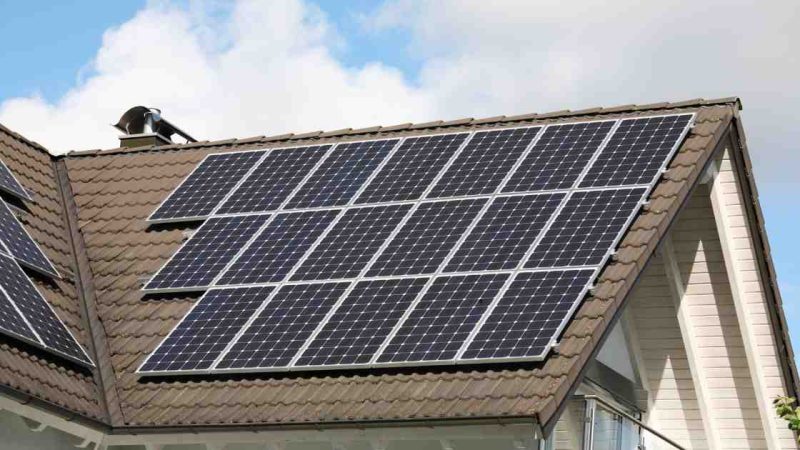Solar panels are a great investment, helping you save on electricity while using clean, renewable energy. However, over time, dirt, dust, pollen, bird droppings, and other debris can reduce their efficiency. Cleaning your solar panels properly ensures they function at peak performance and generate maximum energy.
In this guide, we’ll walk you through how to clean solar panels on your roof safely and effectively, whether you choose to do it yourself or hire professionals.
Table of Contents
ToggleWhy Clean Your Solar Panels?
Dirt and debris can block sunlight from reaching the solar cells, reducing their efficiency by 15–25% over time. Regular cleaning helps:
Improve energy output – More sunlight means more power.
Extend panel lifespan – Removing dirt prevents damage over time.
Maximize savings – A clean system produces more electricity, reducing your bills.
Prevent permanent stains – Bird droppings and tree sap can harden and become difficult to remove.
Step 1: Check Manufacturer Guidelines
Before cleaning, review your solar panel manufacturer’s manual for any specific cleaning recommendations. Some panels come with protective coatings that require special care.
Step 2: Gather Your Cleaning Supplies
To clean solar panels safely, you’ll need:
Soft-bristle brush or sponge – Avoid anything abrasive.
Non-abrasive squeegee – Helps remove excess water.
Bucket of warm water – Cleans most dirt effectively.
Mild dish soap or solar panel cleaner – Avoid harsh chemicals.
Garden hose (low pressure) – Rinses dirt off gently.
Extendable pole – Useful for reaching high panels.
Safety gear – If working on a roof, use a harness and non-slip shoes.
Avoid:
High-pressure washers – Can damage panels and wiring.
Harsh chemicals – Can leave residue or corrode panels.
Metal tools or hard brushes – Can scratch the surface.
Step 3: Choose the Right Time to Clean
Best time to clean: Early morning or late evening when the panels are cool.
Avoid mid-day cleaning – Hot panels can cause water to evaporate quickly, leaving streaks or damage from temperature shock.
Step 4: Rinse Off Loose Dirt
Use a low-pressure garden hose to remove loose dust and debris.
Avoid spraying water under the panels, as it can damage electrical components.
Step 5: Clean with Soapy Water and a Soft Brush
Mix warm water with mild dish soap in a bucket.
Dip a soft sponge or brush into the soapy water.
Gently scrub the panels in circular motions to remove dirt and bird droppings.
Rinse immediately with clean water to prevent soap residue.
Tip: If your panels are difficult to reach, use an extendable pole with a brush attachment.
Step 6: Remove Excess Water and Dry
Use a squeegee to remove excess water and prevent streaking.
Let panels air dry naturally.
Check for remaining spots and wipe them gently with a damp microfiber cloth if needed.
Step 7: Inspect for Damage
While cleaning, look for:
Cracks or scratches on the panel surface.
Loose wires or disconnected cables.
Signs of corrosion around the mounting system.
If you notice any issues, contact a professional for repairs.
Alternative Cleaning Methods
Rainwater Cleaning (For Light Dirt)
If your area gets frequent rainfall, rain can naturally wash away dust.
However, stubborn debris like bird droppings may still require manual cleaning.
Robotic or Automated Cleaners
Some homeowners invest in solar panel cleaning robots for automatic maintenance.
Best for large solar farms or hard-to-reach panels.
Professional Cleaning Services
If your roof is steep or high, consider hiring a solar panel cleaning service.
They use specialized equipment and ensure safe, damage-free cleaning.
How Often Should You Clean Solar Panels?
Every 6 months in areas with low pollution and minimal debris.
Every 3 months if you live near highways, industrial areas, or trees that drop a lot of leaves.
Immediately after a dust storm, wildfire, or heavy bird activity.
Final Safety Tips
Turn off your solar system before cleaning.
Use a sturdy ladder and wear safety gear if cleaning on the roof.
Avoid walking on the panels – They are fragile and can crack.
Work with a partner for added safety.
FAQs
Can I clean my solar panels with a pressure washer?
No, high-pressure water can damage the panels and wiring. Use a garden hose with low pressure instead.
What is the best time of day to clean solar panels?
Early morning or late evening when the panels are cool to avoid water spots and thermal shock.
Do I need to turn off my solar system before cleaning?
Yes, it’s safest to turn off your solar system before cleaning to avoid electrical hazards.
Final Thought
Regular cleaning ensures your solar panels generate the maximum amount of energy, helping you save on electricity and maintain their efficiency for years. By using safe, non-abrasive methods and checking for damage, you can keep your solar system in top shape. If your panels are hard to access or heavily soiled, hiring professional cleaners is a smart choice. A little maintenance goes a long way in protecting your investment and maximizing solar energy production.

